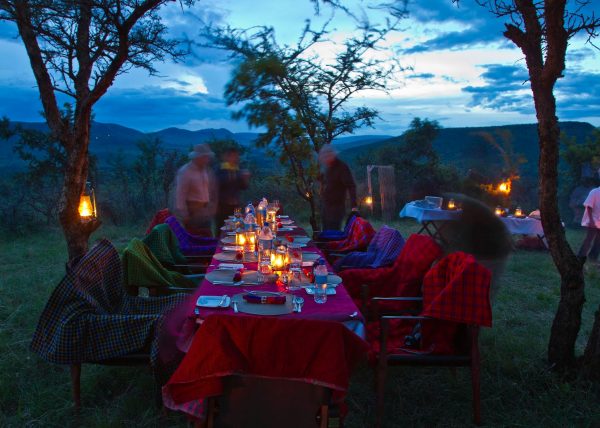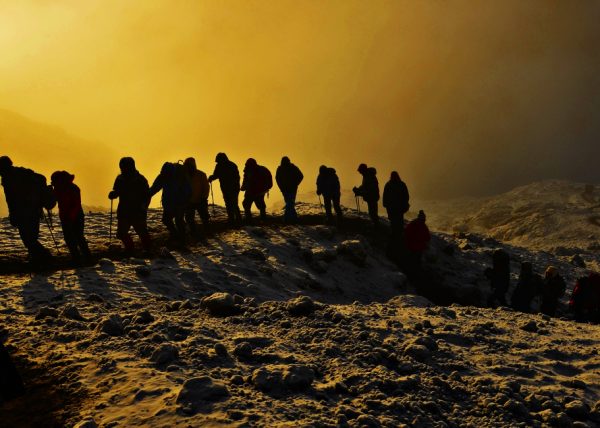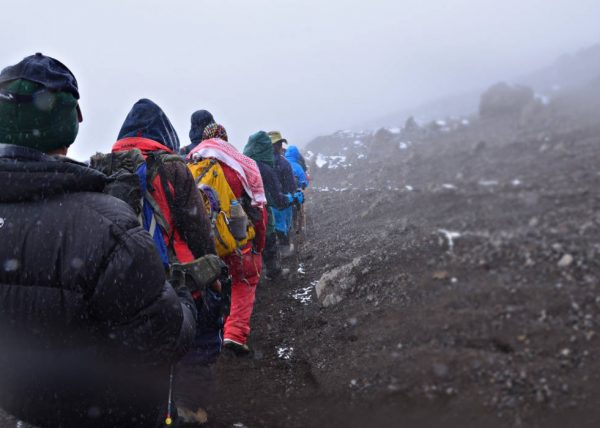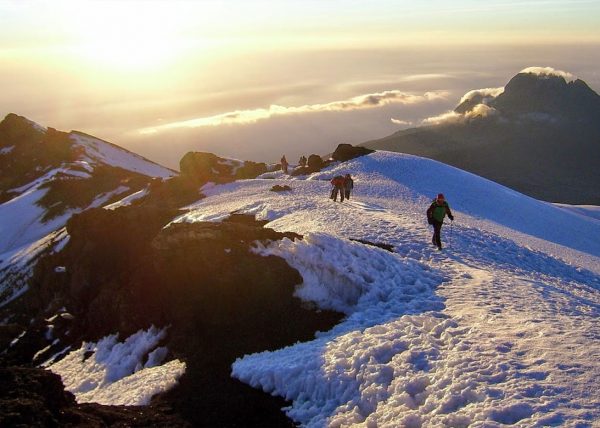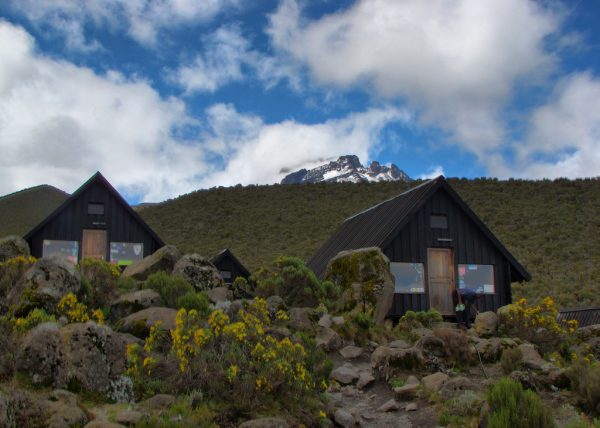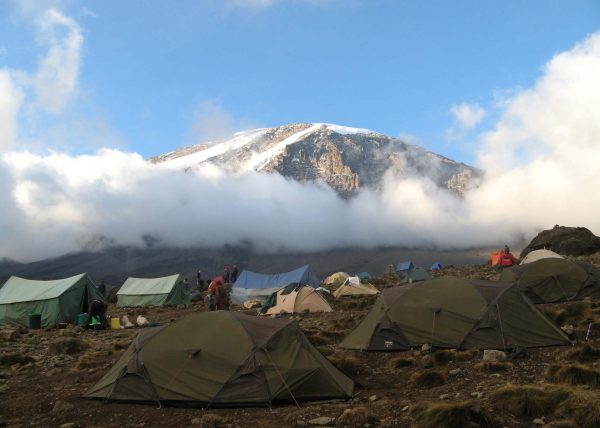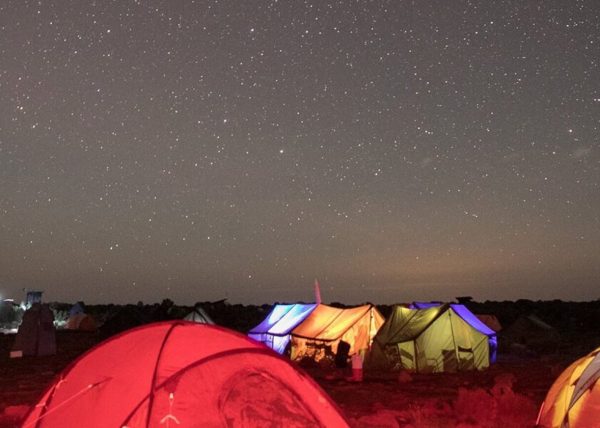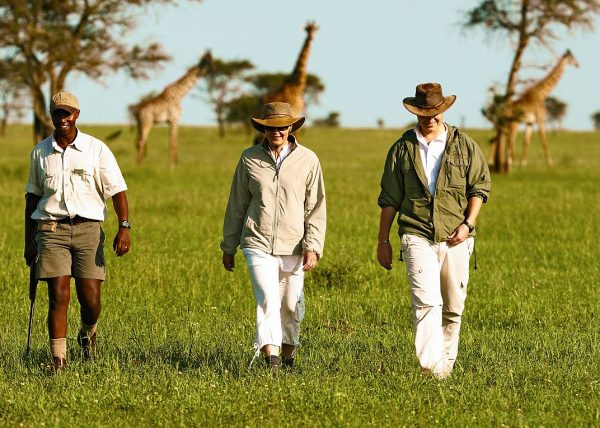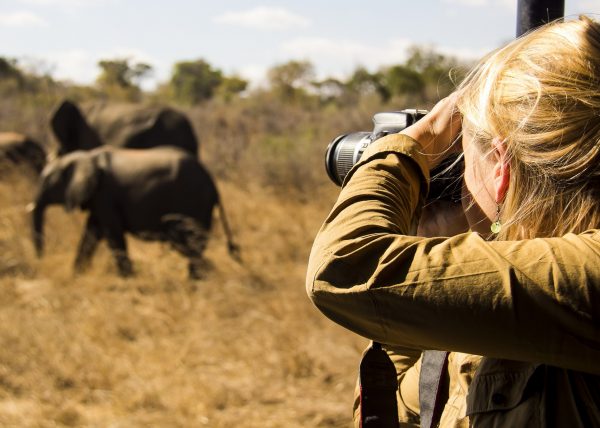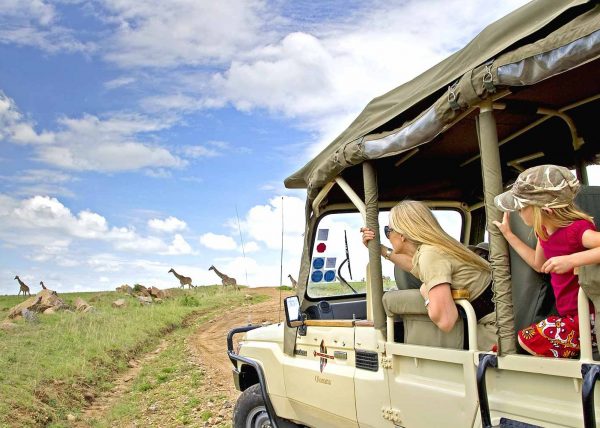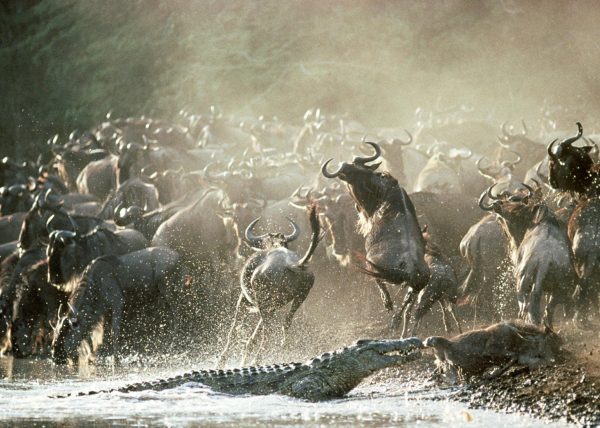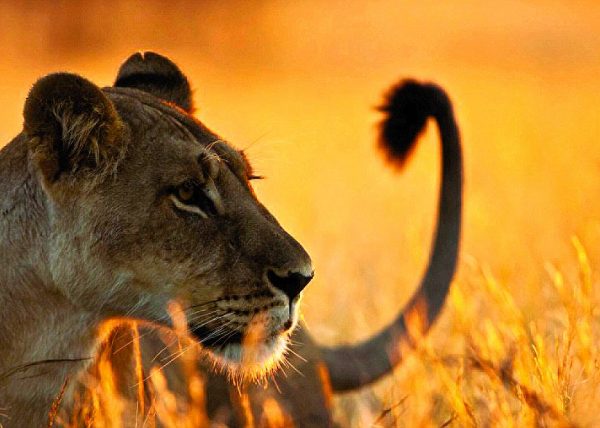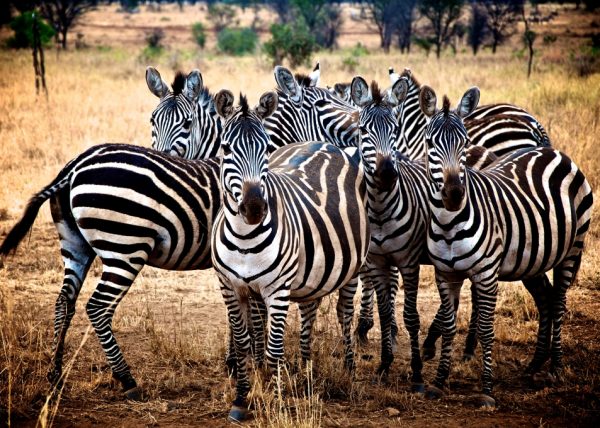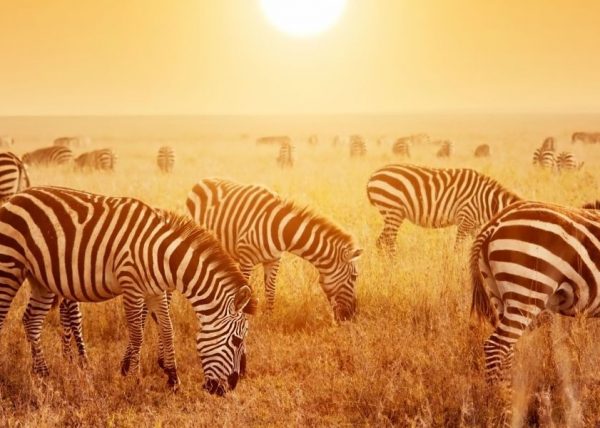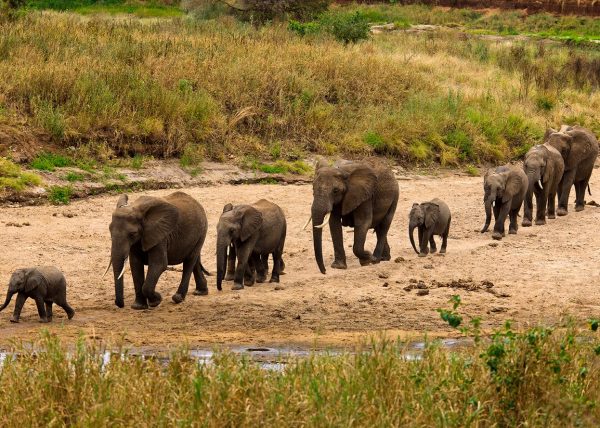Day 1: Fly to Kilimanjaro Airport (JRO)
On arrival at JRO you will be met by our driver with your name clearly marked on a board and transferred to Mount Meru Hotel for an overnight stay. (HB)
I (Nelson) will be at Mount Meru Hotel to meet you and introduce you to your guide. Your guide will give you a climb briefing and answer any questions you have about the climb. He will also do an equipment check to be sure that you are fully prepared.
Day 2: (day 1 on the mountain) – Machame Gate (1,640 meters) to Machame Camp (2,835 meters)
Distance: ~11km / 7 miles
Trekking time: 5-7 hours
Zone: Rainforest
The first day trekking begins at Machame Gate (1,640 meters). Typically you will drive from Arusha to the gate, which takes approximately two hours. On the way you will get to see subsistence farming and the town of Machame. At the Gate you will meet your trekking crew – your guide, porters and cook. There will be a flurry of activity as porters assemble gear for the trek; weighing packs to ensure they don’t exceed 20 kilograms. You, your guide and climbing team will in the meantime begin the ascent through the stunning rainforest that covers the South-West of the mountain. The first day trek on the Machame Route is a long one (~11km / 7miles) and takes approximately 5-7 hours to complete. We will provide a packed lunch on route and 2-3 litres of bottled water. This is the only bottled water you will receive. From here on porters will collect water from mountain streams (if your son fills fit, he can join the porters). The day’s trekking ends at Machame Camp (2,835 meters) which sits near the border of the rainforest zone and the low alpine zone. By the time you arrive your porters will have already setup your camp and tents, and dinner will be served.
Day 3 – Machame Camp (2,835 meters) to Shira Camp 2 (3,850 meters)
Distance: ~5km / 3 miles
Trekking time: 4-6 hours
Zone: Rainforest / Low Alpine Zone
On this day you will rise early, pack your gear and prepare for the trek from Machame Camp to Shira Camp 2 (3,850 meters). The trek is relatively steep as you enter the low alpine zone which is characterized by moorlands and grasslands. Shira Camp 2 sits on a plateau which provides you with the first views of Kibo in the North-West and Mount Meru in the East. This day takes approximately 4-6 hours and covers a distance of 5km / 3miles.
Day 4 – Shira Camp 2 (3,850 meters) to Lava Tower (4,600 meters) and then Barranco Camp (3,900 meters)
Distance: ~11km / 7 miles
Trekking time: 5-7 hours
Zone: Low alpine zone / High alpine zone
Day four is a long and tough trek East off the Shira Plateau through the ‘Garden of the Senecios’, up to Lava Tower and the Shark’s Tooth rock formation at 4,600 meters and then back down via the Southern Circuit to Barranco Camp (3,900 meters). The route is approximately 11km / 7 miles in length and takes 5-7 hours to complete. Although you end the day at a very similar elevation to when you started from Shira Camp, it is arguably one of the most important days on your trek as it gives you a chance to climb high and sleep low which is important for proper acclimatization.
Day 5 – Barranco Camp (3,900 meters) to Karanga Camp (3,960 meters)
Distance: ~5km / 3 miles
Trekking time: 4-5 hours
Zone: High alpine zone
From Barranco camp, famous for its’ giant groundsels (Senecio species), you ascend the Barranco wall and hike glacial valleys to Karanga camp. Today is a relatively short day hiking and lunch is taken at Karanga camp. In the afternoon a walk can be taken with your guides for great views of the Southern walls of Kibo and deep glacial valleys.
Day 6 – Karanga Camp to Barafu Camp (4,680 meters)
Distance: 4 km
Hiking Time: 4-5 hours
Habitat: Alpine Desert
Today is another half day ascending to Barafu camp. Once again lunch is taken in camp allowing plenty of time to relax before the summit bid. Desolate alpine desert and at times strong winds rip over this camp and yet in the evening splendid views of Mawenzi peak are the norm. A relatively early dinner is taken before heading to rest for the evening.
Day 7 – Barafu Camp (4,680 meters) to Uhuru Peak (5,895 meters) and then Mweka Camp (3,100 meters)
Distance: ~4.5km / 3 miles ascent and then 11km / 7 mile descent
Trekking time: 6-8 hours to the summit and then 5-8 hours to Mweka
Zone: Glacial zone and the all preceding zones
Day Seven is summit night (and day)! You will be awoken around 23:30 with hot tea and biscuits. Hopefully you have managed to get a few hours’ sleep; don’t worry if you haven’t as most people struggle to sleep before summit night. Do however make sure that all your kit, including warm clothes, headlamp, insulated water reserves and snacks are ready for a sharp departure at 24:00. The trek up Kibo is steep and slow. The trick is to keep your momentum moving forward, one step at a time. It takes about 6-8 hours to reach the top of the crater rim where you will see the sign for Stella Point (5,739 meters). This is not the summit of Kilimanjaro. You still have another 156 meters of altitude to walk around the crater rim to Uhuru Peak (5,895 meters). We recommend resting briefly at Stella Point and potentially having some hot tea or hot chocolate. Dawn should be approaching. Take a moment to savour where you have got to and then dig deep for the energy to push for the summit. Over 60% of climbers stop at Stella Point but most can make it to the summit if they muster the metal strength to push through. Obviously if you are experiencing severe AMS symptoms you should descend immediately. After reaching the summit of Kilimanjaro, a 4.5km / 3 mile ascent, you still have an 11km / 7 mile descent to Mweka Camp (3,100 meters)! The descent can be very gruelling on your joints. It is recommend you use trekking poles and potentially wear gaiters to avoid fine glacial scree getting into your boots. Mweka is situated in the upper part of the rainforest zone. The richness of oxygen and moisture in the air will be a very welcome surprise.
Day 8 – Mweka Camp (3,100 meters) to Mweka Gate (1,640 meters)
Distance: ~9km / 5.5 miles
Trekking time: 3-5 hours
Zone: Rainforest
Day eight is the final day of trekking on the Machame Route. By now you will be exhausted and probably only thinking about a hot shower. The trek is a pleasant one through the lower rain-forested slopes and down to Mweka Gate (1,640 meters). Although you cover 9km / 5.5 miles, the trek only takes 3-4 hours. Assuming you successfully reach Stella Point or Uhuru Peak you will be presented with official certificates – a green certificate for the former and a gold certificate for the latter. It is customary to tip your trekking crew before being transported back to Mount Meru Hotel in Arusha.
Day 9: Safari from Arusha – Tarangire Maramboi Tented Camp
After breakfast meet your guide and head straight for Tarangire National Park and enjoy a game drive en route to your lodge. This journey is on the main tarmac road for most of the way except the last 10kms when the road turns to muram. Travelling time from Arusha: 2.5hrs.
Tarangire National Park is dominated by the Tarangire River and the Silale Swamp which attract enormous herds of elephants and many other animals in the dry season. The landscape is a rich and varied mix of Baobab trees, Acacia bush, plains, swamps and rocky outcrops or kopjes. The wildlife here is superb and the area actually experiences its own migration – although smaller in scale than the one further north. Elephants are virtually guaranteed here, together with cats and if you are very lucky wild dog. Tarangire is excellent for birds of prey and provides superb habitats for hundreds of other species.
Maramboi is twenty minutes from the main entrance to Tarangire. The camp is in a fantastic location overlooking Lake Manyara in the distance where you can sit and take in your surroundings with views across to the park. There are thirty roomy tents all with en suite shower and toilet and hot showers. The meals here are excellent.
Dinner and overnight at Maramboi Tented Camp.
Day 10 – Tarangire – Ngorongoro Farm House
Following breakfast, go for morning game drives at Tarangire National Park and drive to Ngorongoro highlands through the main town of Karatu. On the way you will stop at a nearby Maasai Boma where you can participate in a variety of unique cultural activities. Arrive at Ngorongoro Farm House in time for late afternoon check into your home for the night.
Day 11 – Karatu – Lake Eyasi (Hadza Culture Tour)
After breakfast your driver will take you on a very rough trail for a 1 hour drive; the road circumnavigates the Ngorongoro crater and head south west to Mongola Village; have a contact to local tribesmen and impression of Barabaig / Hadza / San tribes. The Hadza number just under 1000.Some 300–400 Hadza live as hunter-gatherers, much as their ancestors have for thousands or even tens of thousands of years; they are the last functioning hunter-gatherers in Africa
Therefore I suggest a very early morning (0545am) you’ll drive to the dwellings of the famous Hadzabe tribe in the bush for cultural interaction. Join the Hadza tribe and go to forage, and during the course of day eat while foraging, and also bring back some honey, fruit, or wild game when available.
While traditionally considered an East African branch of the Khoisan peoples, primarily because their language has clicks, modern genetic research suggests that they may be more closely related to the Pygmies. Get an opportunity to walk with them and watch the way they hunt or collect honey and insects. Return to Ngorongoro Farm House for dinner and overnight.
Day 12 – Crater Tour
Ngorongoro is sometimes known as the ‘eighth wonder of the world’; it is the largest volcanic caldera in the world. Almost everybody has heard of the crater and view wise it is on a par with the Grand Canyon.
The Crater covers 260 square kilometers. The balance of predator and prey within the Crater is so precise that animals seldom leave, and it possibly contains the largest permanent concentration of wildlife in Africa, with an estimate of 30,000 large animals.
The expansive floor is predominantly grassland, which provides for excellent game viewing. There are two swamps fed by streams (a favorite for hippo, elephant and reedbuck, among other species) two forests, and a huge soda lake that attracts thousands of flamingos and other water birds. The crater walls themselves are lightly forested and provide a prominent backdrop and a sanctuary for many animals.
Ngorongoro Crater is one of the last places in the world where you have a reasonable chance of seeing the very rare and endangered African Black Rhino, so keep your eyes opened for this majestic mammal.
We would suggest you have an early start this morning. Taking a picnic lunch with you, drive down onto the crater floor and begin your tour of this world famous wonder, to tick off any animals not yet seen and hopefully catch a glimpse of the elusive rhino!
Following your crater tour, drive back to Arusha in time for dinner at Mount Meru Hotel.
Day 13 – Fly back home
Breakfast at Mount Meru hotel and later transfer to Kilimanjaro airport for your flight back home



